Can You Eat Pasta on a Renal Diet?
Kidney disease is a serious medical condition, and taking care of those affected demands the utmost attention. For patients living with kidney disease, having access to nutritious food is essential for managing their health.
But did you know there's one type of food that could be hugely beneficial? Potassium-rich pasta has been shown to help regulate blood pressure in people suffering from kidney problems.
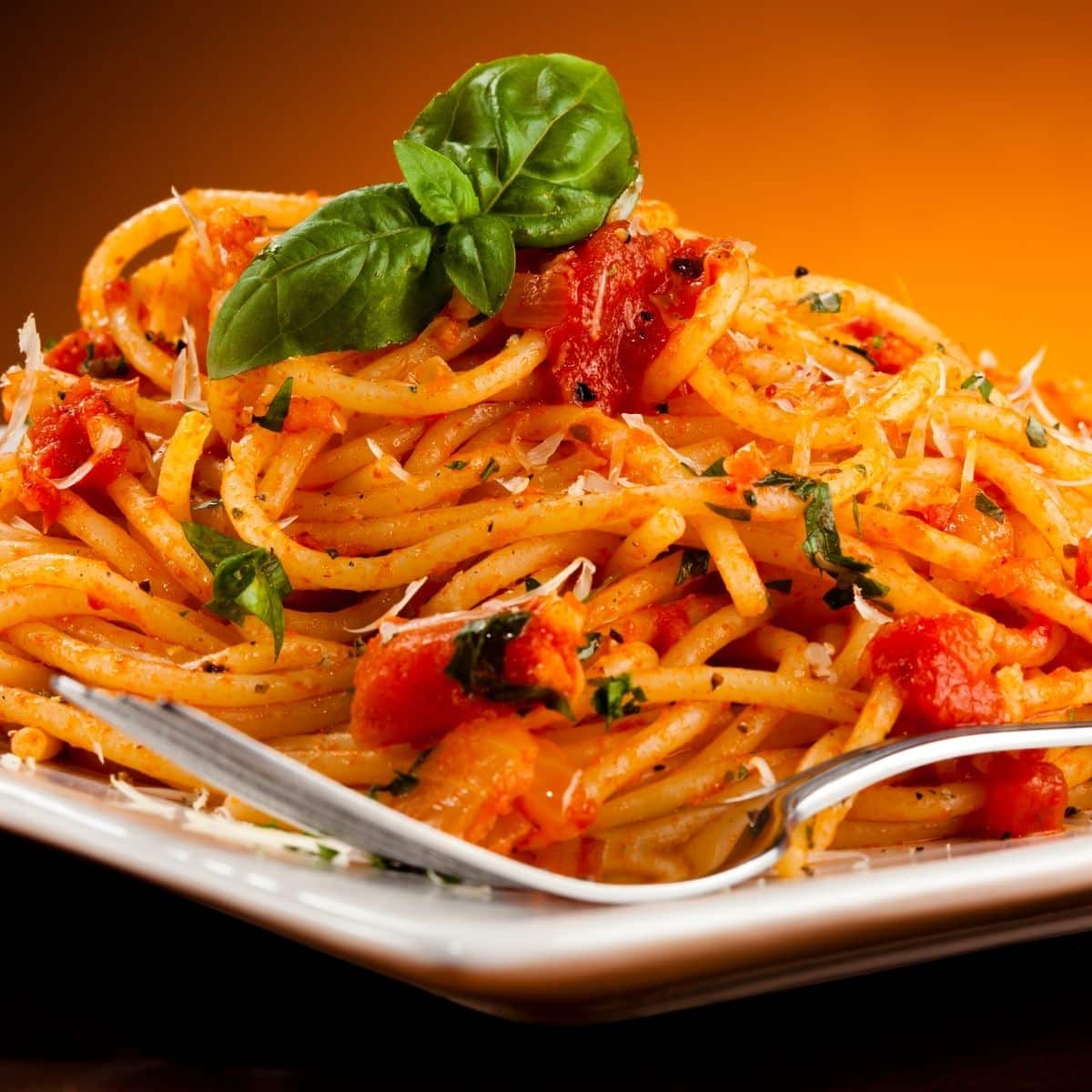
In this article, we'll explore why potassium in pasta can provide relief for those with chronic kidney issues, allowing them to lead healthier lives and eat according to a chronic kidney disease food list. Understanding pasta and kidney disease is a lot easier than you ever thought.
Can You Eat Pasta on a Renal Diet?
Living with renal disease means making significant changes to your diet and lifestyle choices. One of these changes may include reducing your intake of high-potassium foods when following a low potassium diet for kidney disease, such as bananas and potatoes - but what if we told you that eating certain types of pasta could actually give you more potassium?
Potassium-rich whole wheat pastas are specially designed to contain enough potassium per serving to meet dietary needs without putting too much strain on kidneys already under duress.
So how can adding a few extra servings of pasta into your weekly meal plan make a difference? We’ll discuss the benefits of consuming potassium through pasta and just how it can help manage symptoms associated with chronic kidney disease.
Let’s take a look at why potassium in pasta is so important for those battling renal conditions! Understanding a low potassium diet for kidney disease starts with knowing what you can and cannot eat, including pastas!
Jump to:
- Can You Eat Pasta on a Renal Diet?
- Potassium In Pasta
- Low Potassium Pasta
- Eating Pasta With Kidney Disease
- Low Potassium Dishes With Pasta
- Renal Diet Guidelines For Pasta Consumption
- Is Macaroni Good For Kidney Patients?
- What Is The Best Type Of Pasta For Kidney Patients?
- Are Egg Noodles Suitable For People With Kidney Disease?
- Low Potassium Options When Eating Pasta
- Can Dialysis Patients Enjoy Spaghetti?
- Long-Term Impact Of Consuming Pasta On Kidney Health
- Frequently Asked Questions
- Overview of Pasta Noodles For CKD Patients

Potassium In Pasta
For those with kidney disease, pasta can be a blessing or a curse. Like the proverbial two sides of a coin, it all comes down to understanding the potassium content in your favorite spaghetti dish.
Picking up the right ingredients can mean the difference between feeling energized and healthy - or suffering from lethargy and weakness due to an overload of minerals and electrolytes when trying to follow a low potassium diet menu.
Low Potassium Pasta
So, what is pasta's role when managing kidney health? Well, for starters, choosing low-potassium varieties can help prevent excess accumulation that could lead to further complications.
Look for available macaroni made without added salt, which helps lower overall mineral intake significantly. Additionally, you'll want to select types of noodles that are low in phosphorus as well, such as whole wheat pasta, to provide even more support on your path toward better renal health. Wondering when should I limit phosphorus with CKD?
When looking for options at grocery stores or online, don't forget about fiber-rich choices like quinoa and lentil pastas! Not only do they have fewer calories than traditional semolina varieties, but their high nutritional value makes them an ideal choice for those wanting to optimize their dietary needs while still enjoying one of life's greatest treats: eating delicious carbs!
Some sample amounts for low potassium pasta are:
- Egg noodles per 2 ounce uncooked portion contain 139 mg potassium
- Rice noodles per 2 ounce uncooked portion contain 17 mg of potassium
- Corn pasta, which is gluten free, contains about 168 mg potassium per 2 ounce uncooked serving
- Shirataki Noodles, according to nutrition labels, contain 0 mg potassium per serving
Eating Pasta With Kidney Disease
Eating pasta can be a challenge for those with kidney disease. After all, it is high in potassium and phosphorus which are usually restricted on renal diets.
Fortunately, there are plenty of ways to add pasta back into your diet while still staying within the guidelines of a renal diet, especially when using a Comprehensive Healthy Renal Diet Grocery List Guide .
First, aim to make substitutions such as using lower-potassium noodles like zucchini noodles or shiitake noodles instead of regular wheat-based spaghetti or macaroni.
Store Bought Kidney Friendly Pasta
You can look for store-bought “kidney friendly” pastas that have been specially formulated for those with kidney disease. These may contain fewer amounts of potassium and phosphorus than traditional pastas.
Consider recipes that use low-potassium ingredients alongside the pasta you choose. For example, if you select whole wheat spaghetti noodles, pair them with a homemade roasted red pepper sauce made from red peppers that are low in potassium. This will help keep the overall potassium content low in your meal.
By making smart food choices when it comes to adding pasta back into your diet, you can enjoy meals that taste great without compromising your health goals!
If you want to try pasta and you have kidney disease, give this kidney friendly pasta salad a try!
Low Potassium Dishes With Pasta
Fortunately, there are many delicious low potassium pasta dishes that can be enjoyed by those on a renal diet. With careful planning and preparation, individuals with kidney disease can still enjoy their favorite dish of pasta without having to worry about the effects of high levels of potassium in the food they consume.
One great option is to make use of lower potassium vegetables such as mushrooms, bell peppers, onions or garlic. These ingredients can add flavor and texture while not drastically increasing the amount of potassium consumed during meals.
It is important to look for reduced-sodium tomato sauces when making any type of pasta dish - this will also help keep potassium and sodium levels under control. Can you eat tomato sauce with kidney disease?
Finally, if you're looking for some truly unique recipes that fit within your renal diet requirements, consider trying out roasted vegetable pasta primavera or even Mediterranean lentils and spinach over spaghetti squash.
Both dishes offer tasty options that contain fewer amounts of sodium and potassium than traditional pastas. In addition, these recipes are full of fresh flavors that won't leave you feeling deprived!
Renal Diet Guidelines For Pasta Consumption
Potassium content is one of the main concerns when it comes to cooking pasta for kidney patients. However, by following some general guidelines and understanding which types of pasta contain less potassium, creating delicious meals is possible.
- Be mindful of portion size: Eating large amounts of pasta can increase your potassium intake significantly. Renal diet meat portion control is important!
- Choose low-potassium brands: Certain pastas such as quinoa, millet or brown rice noodles have lower levels of potassium than traditional wheat-based varieties like spaghetti and macaroni. Is quinoa high in potassium?
- Cook with care: Boiling water may increase sodium concentrations in foods, so be sure you don’t overcook your meal!
When preparing recipes for dialysis patients featuring pasta dishes such as lasagna or spaghetti and meatballs, make sure to opt for lower-potassium alternatives and serve smaller portions in order to keep their dietary needs in check.
Using other ingredients such as bell peppers, mushrooms or spinach added to the dish will help reduce overall potassium content while adding flavor at the same time.
Pasta can still be included in a renal diet plan; just remember to pay attention to portion sizes and choose low-potassium options whenever possible. With these simple tips in mind, everyone can enjoy enjoyable meals regardless of their health restrictions.
Is Macaroni Good For Kidney Patients?
When it comes to pasta, kidney patients have some unique dietary considerations. For example, those with Chronic Kidney Disease (CKD) may need to limit their sodium and phosphorus intake while still getting enough potassium in the diet.
While eating a balanced diet is important for everyone, this is even more critical for CKD patients because of the mineral restrictions. So, when it comes to macaroni, is it good for kidney disease? You might be preparing to make some low sodium potluck dishes, and need to use pasta!
The answer depends on several factors. From an overall nutrition standpoint, most varieties of macaroni contain complex carbohydrates and small amounts of protein that can provide energy without stressing your kidneys too much.
However, many commercial brands are high in sodium and phosphorus so they should be avoided by CKD patients unless you make them at home using fresh ingredients or low-sodium alternatives.
Since macaroni does not naturally contain any significant amount of potassium, CKD patients must find other sources such as fruits and vegetables in order to ensure adequate levels in the diet.
Fortunately, there are plenty of delicious ckd pasta recipes available that are suitable for people with kidney problems. These generally include options like whole wheat penne or linguine made with olive oil instead of butter which helps reduce saturated fat intake while keeping sodium levels lower than regular versions. Eating lower fat can be part of heart healthy lifestyle changes for CKD.
Adding extra vegetables like spinach or bell peppers into dishes adds additional flavor while providing essential vitamins and minerals including potassium. By following these tips, CKD patients can enjoy delicious pasta dishes while managing their health needs properly.
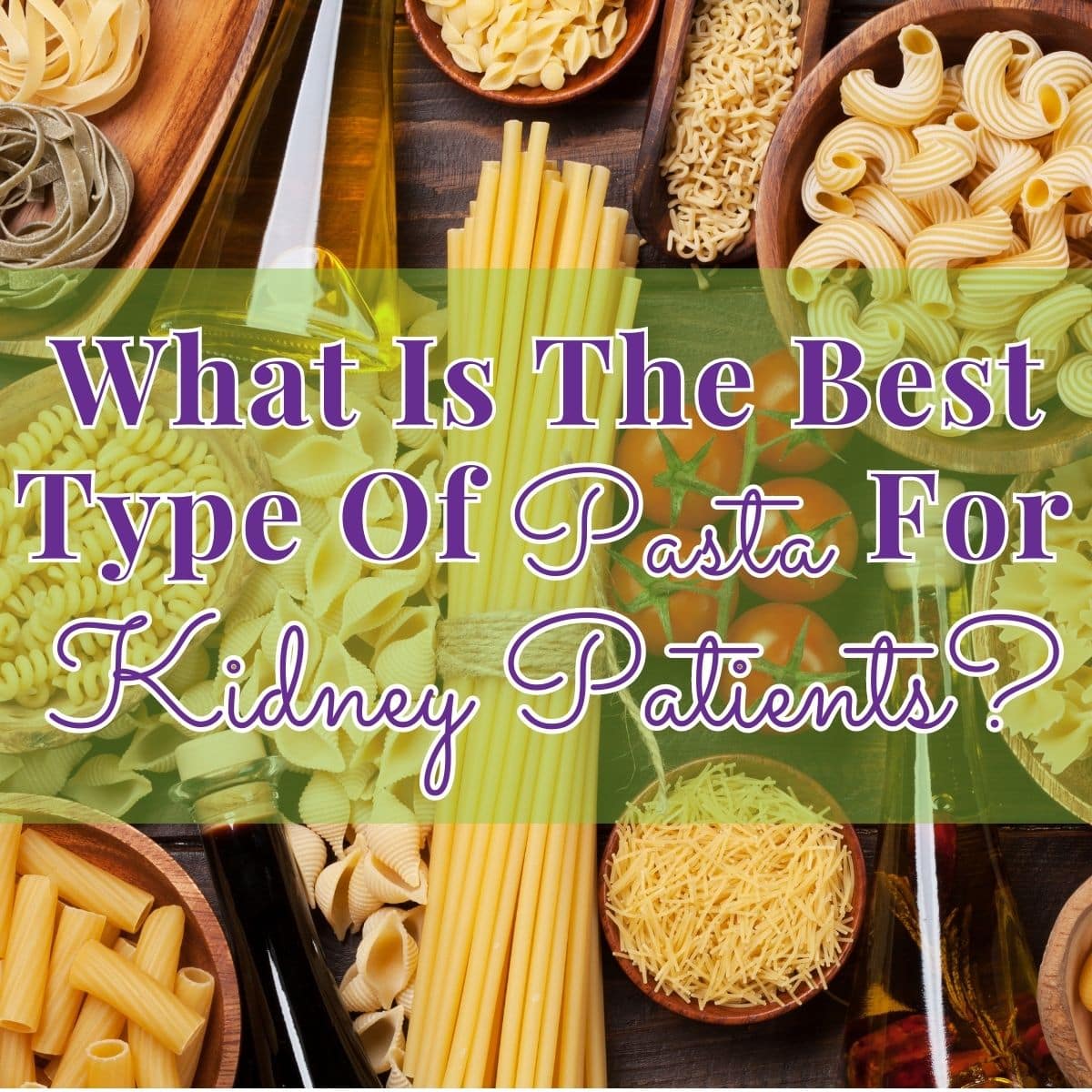
What Is The Best Type Of Pasta For Kidney Patients?
With pasta being a popular dish among many people, the question arises: is spaghetti good for those with kidney disease? Can dialysis patients eat spaghetti?
The short answer is yes; however, there are certain considerations when selecting which type of pasta is best. Generally speaking, whole-grain varieties are recommended over white flour pastas due to their higher fiber content.
Potassium is an important mineral associated with healthy nerve and muscle function, but some forms may be difficult or even dangerous for patients on dialysis as high levels can lead to heart problems.
Therefore, it’s important for kidney patients to keep track of their potassium intake and look for low-potassium options such as quinoa noodles or rice noodles. Check out this Quinoa Renal Diet recipe also known as a Quinoa Salad.
Other ingredients should also be taken into account. For instance, tomato-based sauces tend to contain more sodium than cream or olive oil sauces, something else renal dieters need to be aware of.
Furthermore, adding vegetables like mushrooms or spinach is always a great way to get extra nutrients while keeping things light and tasty!
It’s possible for kidney disease patients to enjoy delicious pasta dishes provided they pay attention not only to the types of pasta used but also any toppings added on top. By choosing lower potassium alternatives and avoiding excess salt, you can still indulge without putting your health at risk!
Are Egg Noodles Suitable For People With Kidney Disease?
Many kidney disease patients are concerned about their potassium intake. Some changes are related to diet changes by stage of chronic kidney disease. Potassium is an essential mineral that helps regulate nerve and muscle function as well as blood pressure, yet too much of it can be dangerous for those with kidney issues. So, when it comes to pasta, is pasta high in potassium?
The answer depends on the type of pasta you choose. Generally speaking, egg noodles have a moderate level of potassium compared to other types of pasta like whole wheat or legume-based pastas which tend to be higher in potassium content.
When choosing a type of pasta for someone with kidney disease, it’s important to take into account not only the nutrition facts label but also the ingredients list.
Whole wheat pastas usually contain more fiber than white flour varieties, so these would make a better choice if your goal is to promote good health overall.
Legumes such as chickpea or lentil-based pastas provide additional sources of protein and nutrients while still having lower levels of sodium and phosphorus than regular noodles do.
Look out for added sugar or sodium in any kind of packaged food product as these can further increase risk factors associated with chronic diseases such as diabetes and hypertension.
It's best to discuss dietary choices with your doctor before making any changes in order to ensure that whatever food items you select meet your nutritional needs without causing more harm than good over time.
For More Recipes and Ideas --->> Get Your Free Meals and Recipes That Are Perfect for Pre-Dialysis Diets, Pre-Dialysis with Diabetes, or Dialysis Diets.
Low Potassium Options When Eating Pasta
Kidney disease patients must watch their diets carefully, especially when it comes to phosphorus and potassium levels.
Pasta is a great way to get your carbs while limiting the amount of phosphorus intake. But what about potassium? Is it safe for kidney disease patients to eat pasta with high amounts of this mineral?
Low Potassium Options
The good news is that there are plenty of low-potassium options out there! Whole wheat varieties tend to contain less potassium than other types of pastas, making them ideal for those trying to keep potassium levels in check.
Veggie-based pastas–such as ones made from lentils or chickpeas–are also lower in potassium content. These alternative variations provide an excellent source of fiber and protein too!
There are also plenty of delicious recipes available online specifically designed for those on a kidney friendly diet. From creamy cauliflower mac & cheese to hearty lasagna bakes – these dishes prove that eating healthy can still be enjoyable.
By following some simple guidelines, you can make sure your meals stay within the recommended limits for both phosphorus and potassium intake, so you can continue living life without having to sacrifice flavor or nutrition! Make sure you pay attention to meat low in phosphorus.
Can Dialysis Patients Enjoy Spaghetti?
Dialysis patients often struggle to find meals that meet their dietary needs. Potassium is one of the primary concerns for those with kidney disease, as high levels can be dangerous.
Fortunately, there are plenty of delicious pasta dishes that dialysis patients can enjoy while also managing potassium intake.
Suggested Dishes And Cooking Tips
- Low - Shrimp Alfredo, Eggplant Parmesan Lasagna, Macaroni and Cheese Season with herbs like oregano or basil instead of salt-based seasonings. Cook in small batches and refrigerate leftovers quickly.
- Medium - Spaghetti Carbonara, Rigatoni Bolognese, Fettuccine Alfredo Avoid adding bacon, cheese, olives, mushrooms, and other ingredients high in sodium. Use low sodium chicken broth for extra flavor.
- High Fusilli Marinara Cavatappi, Primavera Penne Alla Vodka Go light on the sauces when cooking your dish. Avoid using shrimp high in creatinine due to its higher content of phosphorus and potassium.
Pasta dishes offer a wide range of flavors and textures that make them an ideal choice for dialysis patients looking to add variety to their diets without sacrificing nutrition.
With some simple modifications, you can create tasty meals that support healthy kidney function. By paying attention to the best pasta options for kidney disease along with proper portion sizes and thoughtful seasoning choices, it's possible to serve up flavorful Italian cuisine even if you're on dialysis - it's not a dialysis diet food to avoid!
If you really want to avoid spaghetti, give low sodium spaghetti squash recipes a try!
Long-Term Impact Of Consuming Pasta On Kidney Health
John is a kidney disease patient who loves eating pasta. He has been told to watch his sodium intake and must follow a strict diet. John often finds himself wondering if it's safe for him to eat the egg noodles he likes so much, or any kind of pasta at all.
The answer lies in understanding the long-term impact that consuming pasta can have on those with chronic kidney diseases like John’s. Eating too much pasta regularly may result in an increase of phosphorus levels in your body in patients with CKD, which could lead to further complications down the line.
Blood Sugar Spikes
High amounts of carbohydrates found in some types of pasta might cause blood sugar spikes which can cause damage to already weakened kidneys over time. It is important for those with kidney diseases to monitor their carbohydrate consumption, while also ensuring they are getting enough protein into their diets; this balance helps protect overall renal health and following a renal diabetic diet.
Be Mindful of Adding Pasta
Therefore, people living with kidney conditions should be mindful when adding pasta as part of their meal plan:
- Carefully consider portion sizes and frequency of consumption.
- Choose lower carb options such as whole wheat varieties whenever possible to increase fiber in the diet.
- Look out for added ingredients like salt or cheese that can add extra sodium or other unhealthy compounds.
- Make sure there is an adequate amount of healthy proteins accompanying the dish.
Be Proactive
In order to maintain a balanced lifestyle without putting unnecessary strain on fragile organs, individuals like John must take proactive steps towards being aware of what they eat and how it affects them in the long run.
This is especially true when considering food items such as pastas that provide comfort but do not necessarily support optimal health outcomes.
Serving up delicious meals doesn't have to mean sacrificing health; being mindful about food choices will go a long way towards helping kidney patients stay healthier longer.
By including low-sodium alternatives like whole wheat pastas alongside plenty of fresh fruits and vegetables, along with adequate hydration, individuals living with CKD can enjoy balanced meals while still looking after their own wellbeing!
Frequently Asked Questions
When it comes to pasta, one of the most important things to consider is how much potassium is typically found in a serving. For those who suffer from kidney disease, this could be particularly pertinent information that helps them determine whether they should include pasta as part of their diet.
To get an accurate answer for this question, it’s necessary to look at the type of pasta being consumed and also the size of each individual portion. Generally speaking, when cooked correctly, a cup (or two ounces) of dry pasta contains between 75–125 milligrams (mg) of potassium per serving.
This range can vary depending on certain factors such as if salt was added during cooking or if any additional ingredients were included with the dish.
The goal here is to provide clarity so that consumers are aware of what they're putting into their body and can make informed decisions about their diet accordingly.
By understanding exactly how much potassium is present in a standard serving of pasta, individuals can easily adjust their intake based on particular health needs. It's always best to consult with your doctor first before making changes to any dietary habits.
Are there any substitutes for pasta that have a low potassium content? It's an important question to consider when it comes to kidney disease patients. With the right dietary choices, people with chronic kidney disease can reduce their risk of complications and improve their quality of life.
So what are some healthier alternatives for those who need to watch their potassium intake? Fortunately, there are several delicious options available!
Whole-grain breads such as whole wheat or multigrain contain significantly less potassium than traditional white pastas. Other grains like quinoa, buckwheat and millet also offer nutritionally diverse benefits.
Alternatively, legumes like beans, lentils and chickpeas make great additions to any meal and provide protein along with fiber and other essential vitamins and minerals. Which lentils are good for kidney disease?
Finally, vegetables like zucchini noodles (also known as u0022zoodlesu0022) or spaghetti squash can be used in place of traditional noodles while still providing flavorful dishes.
Not only do these plant-based sources offer lower levels of potassium, but they're also rich in antioxidants which may help protect against heart diseases and other health conditions associated with kidney dysfunction.
All in all, there are many creative ways to enjoy healthy meals without sacrificing taste or nutrition – even if you're watching your potassium intake!
It’s a common question: “Are all types of pasta suitable for people with kidney disease?” You may be surprised to learn that the answer isn't so straightforward.
For those suffering from this condition, it can be difficult to know what kinds of food they should and shouldn't eat. Let's take a look at some factors to consider when choosing which type of pasta is best for someone with chronic kidney disease (CKD).
When it comes to selecting an appropriate meal option, there are several important things you should keep in mind. Firstly, if you're dealing with CKD, it's essential to avoid high-potassium foods like potatoes or bananas.
Many pastas contain phosphorus and sodium; both of these compounds must also be avoided by CKD patients. Certain varieties such as whole wheat pastas tend to have more fiber than white varieties and can be beneficial for regulating blood sugar levels in diabetics.
So, how do we choose the right kind of pasta? To start, opt for a low potassium variety such as quinoa or buckwheat noodles, both are gluten-free and free of added sodium or other preservatives.
If possible, try to find brands that don't use processed flours either. These are typically higher in carbohydrates and lower in nutrients than unprocessed grains like spelt or millet flour.
Make sure to read labels carefully before purchasing any product – even if something says u0022low sodiumu0022 on the package doesn't necessarily mean it will meet your nutritional needs!
Armed with this information, now you can select pastas that work well for your diet without sacrificing flavor or nutrition. With careful consideration, anyone living with CKD can enjoy delicious meals while staying within their dietary restrictions and working on how to manage chronic kidney disease.
When it comes to kidney disease patients and pasta, there is often concern about how often they should consume it. While protein-restricted diets are typically recommended for those with kidney diseases, this doesn't have to mean a complete avoidance of all types of pasta.
The key factor in determining whether pasta can be consumed by a kidney patient is the quantity and type of potassium present in each serving.
Potassium is an essential mineral that helps regulate blood pressure and muscle function, but too much of it can cause adverse effects in people with impaired renal function.
That said, if the amount of potassium per serving falls within safe levels, then eating moderate amounts of pasta every once in a while could still be beneficial.
In order to ensure that their consumption remains healthy, however, kidney disease patients should talk to their doctor first before incorporating any new foods into their diet, including pasta.
Their physician will be able to advise them on which types and quantities are best suited for their individual needs. Individuals may also want to consider using lower sodium varieties or preparing homemade recipes whenever possible. These options tend to have fewer additives than store-bought brands without sacrificing flavor.
Sodium is a major concern for people living with kidney disease. With their kidneys unable to filter out high levels of sodium, it becomes increasingly important for them to pay attention to the amount of salt they consume in their diet. But how does the presence of sodium in pasta affect those with kidney disease?
When it comes to dietary considerations for those with impaired renal function, there are some key points that should be taken into account. Fluid restriction guidelines for CKD can vary depending on stage of disease. For starters, understanding the effects of sodium on blood pressure and fluid retention can help individuals make informed decisions when choosing foods. Here’s an overview of what you need to know:
Sodium has been linked to an increased risk of hypertension, or high blood pressure. High blood pressure places additional strain on already weakened kidneys and can worsen existing conditions over time.
Excess consumption of sodium can cause your body to retain extra fluids which puts added stress on both your heart and your kidneys as they work harder than normal to flush out these excess fluids.
Eating too much salt also affects electrolyte balance as it causes calcium excretion through urine due to its influence on acid-base balance within the body. Something that's particularly problematic for those suffering from chronic kidney diseases (CKD).
So what about eating pasta? While typically considered a healthy option, all types of pasta contain varying amounts of sodium depending on ingredients and cooking methods used.
As such, individuals with CKD must pay close attention not only to the type but also the quantity consumed in order to maintain healthy intake levels and avoid any undesirable side effects caused by excessive amounts of this mineral.
You may find yourself following a following a low sodium kidney diet and that's ok!
Overview of Pasta Noodles For CKD Patients
It is important for kidney disease patients to be aware of the potential health risks associated with eating pasta. While a serving of pasta can provide some essential nutrients, it also contains large amounts of potassium and sodium, which can prove dangerous if consumed in excess.
Fortunately, there are alternatives that offer lower levels of both potassium and sodium while still providing dietary benefits.
When making food choices, people with kidney disease should consider their individual needs and consult a doctor or nutritionist before consuming any type of pasta.
It’s also important to remember to keep portion sizes moderate (listen to some portion control secrets) and not overindulge too often. With careful monitoring and smart decisions, those living with kidney disease can enjoy the occasional meal of delicious pasta without having to worry about its effects on their kidneys.
Ultimately, understanding what goes into our diets is key for best managing kidney diseases like CKD. Eating foods with low levels of potassium and sodium can help ensure we stay healthy, even when indulging in something as tasty as a plate full of pasta!





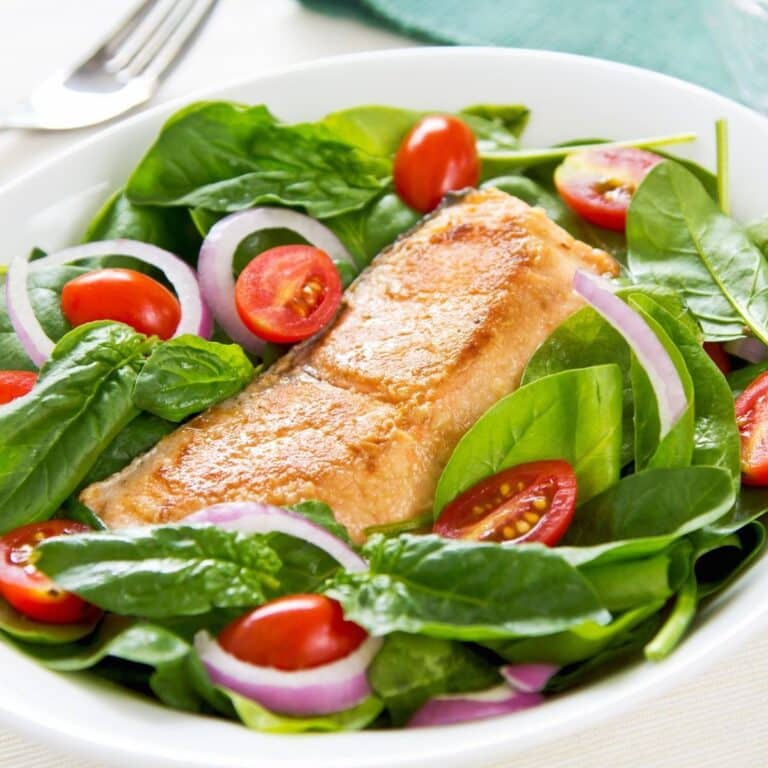
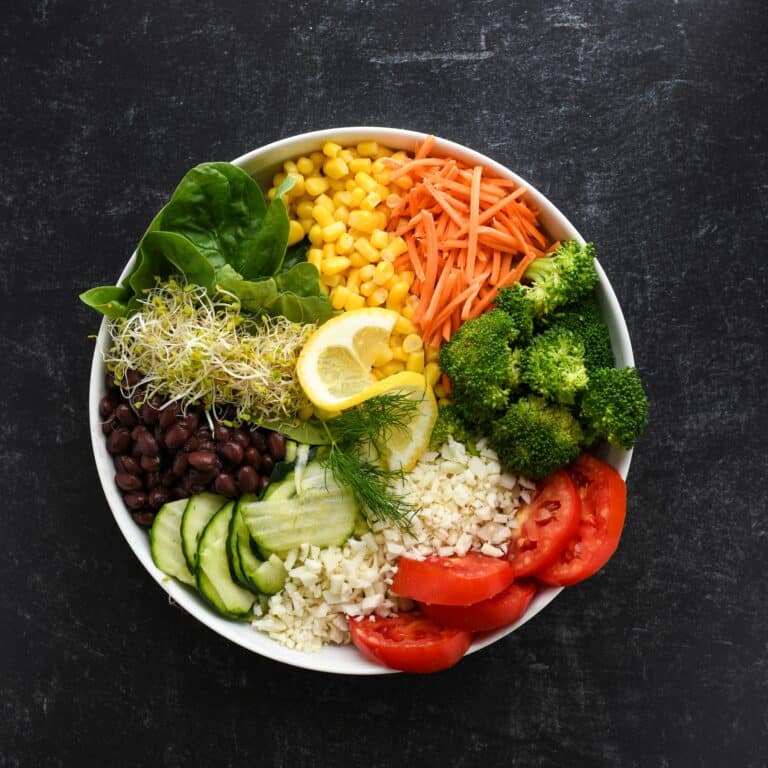
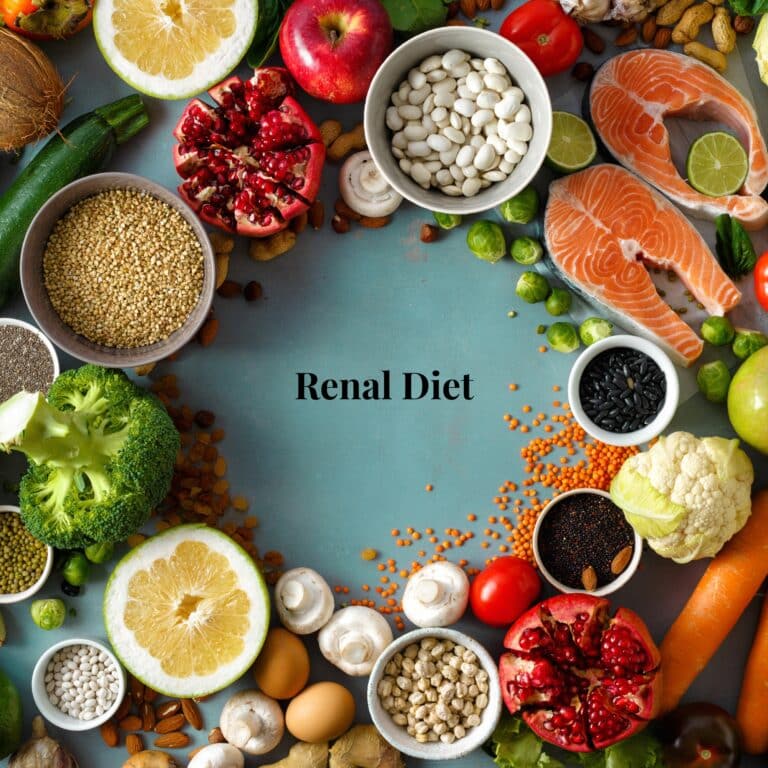



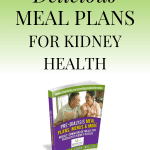
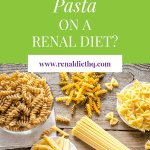

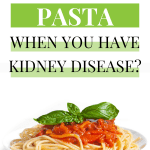
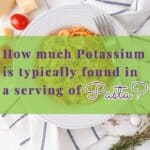




thank you so much.
I found. recipe for red pepper pasta sauce that sounds great. onions, garlic, mrs dash basilp
my creatine is 3.26
what stage kidney disease is that?
I was told to drink more water.
Also is spaghetti sauce bad for kidneys if limited amount